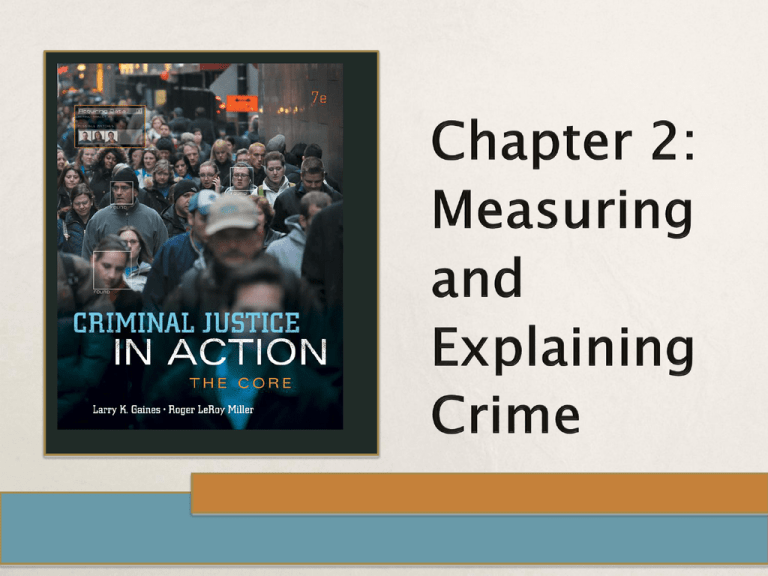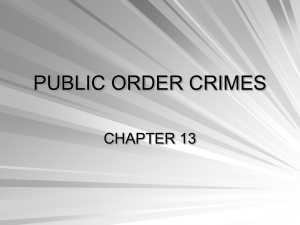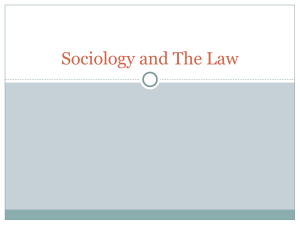
Focus
Question
Explain the
difference between
Burglary and
Robbery.
Burglary refers to the unlawful entry of a structure
with the intent of committing a theft
Robbery is the act of taking property from a person
with the use of force or threat and with the intent of
keeping that property.
Learning Objective 1
Identify the six different main categories of
crime
Types of Crime
Violent Crime:
Crimes against
persons
Four categories
① Murder
② Sexual
assault/rape
③ Assault/battery
④ Robbery
Property Crime:
Crimes of economic
gain or property
damage
Four categories
① Burglary
② Larceny/theft
③ Motor vehicle
theft
④ Arson
Types of Crime
Public Order Crime:
Behaviors considered
contrary to public
values and morals
Sometimes (incorrectly)
referred to as “victimless” crimes
White Collar Crime:
Illegal acts committed
by an individual or
business entity
Difficult to measure
Types of Crime
High-Tech Crime
Crimes directly related
to the increased use of
computers and
technology by society
Organized Crime
Illegal crimes by illegal
organizations, geared
towards satisfying the
public’s need for illegal
goods and services
Fla. Statute 784.046
Action by victim of repeat violence, sexual violence, or dating
violence for protective injunction; dating violence
investigations, notice to victims, and reporting; pretrial release
violations; public records exemption.—
(1) As used in this section, the term:
(a) “Violence” means any assault, aggravated assault, battery,
aggravated battery, sexual assault, sexual battery, stalking,
aggravated stalking, kidnapping, or false imprisonment, or any
criminal offense resulting in physical injury or death, by a person
against any other person.
) “Sexual violence” means any one incident of:
1. Sexual battery, as defined in chapter 794;
2. A lewd or lascivious act, as defined in chapter 800,
committed upon or in the presence of a person younger than 16
years of age;
3. Luring or enticing a child, as described in chapter 787;
4. Sexual performance by a child, as described in chapter 827;
or
5. Any other forcible felony wherein a sexual act is committed
or attempted,
regardless of whether criminal charges based on the incident
Learning Objective 2
Distinguish between Part I and Part II
offenses as defined in the Uniform Crime
Report (UCR)
The Uniform Crime Report
One major data source for criminologists
17,500 policing agencies participate - send
annual data on
The data is the reported as a
Arrests
Crimes reported
Officers and support specialists
Rate per 100,000 persons
Percent change from previous years
Divides criminal offenses into two categories
Part I Index Offenses
Part II Index Offenses
Part I Offenses
Crimes considered to be the most serious
Information collected on “known” offenses:
Part II Offenses
All other crimes recorded by the FBI
Measured only by “arrest” data:
Learning Objective 3
Distinguish between the National Crime
Victimization Survey (NCVS) and selfreported surveys
Victim Surveys
Second major data source for criminologists
Annual survey of households that collects
information about victimization experiences
Advantages over UCR data:
Measures reported and unreported crime
Unaffected by police bias and distortions in
reporting crime to the FBI
Does not rely on victims reporting crime to
police
Self-Reported Surveys
Third major data source for criminologists
Participants report their criminal behaviors
Research suggests they are forthcoming and
honest
Compared to UCR and NCVS, self-report data offers
the best measure for the dark figure of crime
Crime Trends in the United
States
Crime in the 1990s and 2000s
Dropped steadily throughout mid 1990s
Leveled off for a few years
Has begun to decrease again
Not all societal groups benefited equally from this
positive crime trend
Race
Class
Ethnicity
Gender
Bill Quigley, the Legal Director for the Center for
Constitutional Rights, recently made the argument that “the
biggest crime in the CJS is that it is a race-based
institution…” He cites thirteen examples to support his
opinion, including; (1) the police stop and frisk blacks and
Latinos at a much higher rate than whites; (2) blacks are
arrested for drug offenses at rates 2 to 11 times higher than
for whites; (3) once arrests, blacks are more likely than whites
to remain in jail pending trials; (4) blacks are frequently
excluded from criminal jury service (especially on death
penalty cases); (5) black men are 5 times and Latino men are 3
times as likely as white men to go to jail.
Are Quigley’s examples illustrative of racism in the CJS?
What other factors might account for these statistics?
Assuming these examples are illustrative of racism, what are
the implications for the CJS? Is it that these are mistakes of
an otherwise “good” system, or is it that the system is
working exactly how it should – as a system to marginalize
and control minorities?
Learning Objective 4
Discuss the prevailing explanation for the
rising number of women incarcerated in
the United States
Women and Crime
Over the past few decades, the rate of arrests for
women increased more rapidly compared to
men
Explanations:
The life circumstances and behavior of women
dramatically changed in the past 40 years
The criminal justice system’s attitude toward
women has changed over the past 40 years
Learning Objective 5
Discuss the difference between a
hypothesis and a theory in the context of
criminology
The Role of Theory
Criminology:
Hypothesis:
The scientific study of crime and the causes of
criminal behavior
A possible explanation for an observed occurrence
that can be tested by further investigation
Theory:
An explanation of a happening or circumstance
that is based on observation, experimentation, and
reasoning
Types of Theories
Choice Theories
Behavior is the result of
free will
Criminals find crime
more attractive than
law abiding behavior
Threat of punishment is
the only deterrent to
crime
Trait Theories
Behavior is the result
of biological, social,
and psychological
forces
Criminals are driven to
crime by external
factors
Rehabilitation is the
only deterrent to crime
Sociological Theories
Social Disorganization Theory:
Strain Theory:
Crime is more likely in communities where social
institutions fail to exert control over the
population
Crime is the result of frustration felt by those who
can’t reach their goals through legitimate means
Conflict Theory:
Crime is the result of the unequal structure of
society and the resulting class conflict
Social Process Theories
The “Abandoned Car Experiment”
Potential for criminal behavior exists in everyone
Considers criminal behavior to be the predictable
result of a person’s interaction with his or her
environment
Learning Objective 6
List and briefly explain two important
branches of social process theory
Social Process Theories
Learning Theory
Criminals must be
taught both the
practical and emotional
skills necessary to
participate in illegal
activity
Positive/negative
reinforcement from
family, peers, and
media
Control Theory
All individuals have
potential for criminality,
but are restrained
because it would
damage their bonds to
society
Attachment to,
commitment to,
involvement with and
belief in societal values
Learning Objective 7
Explain the theory of the chronic offender
and its importance for the criminal justice
system
Criminology and the Chronic
Offender
Individual who commits multiple offenses
Responsible for a disproportionately large
percentage of all crimes
The notion of a “chronic 6%”
Have strategies and laws to identify and convict
chronic offenders
Goal is to reduce overall crime rates
One of the most controversial laws passed geared toward
chronic offenders is the “three-strikes law,” which mandates
life in prison for offenders convicted of their third felony.
Critics point to high profile cases (such as the man sentenced
to life for stealing a slice of pizza) to illustrate the flaws in the
application of the law. A group of Stanford University
Professors garnered enough signatures to have a measure on
the November 2012 ballot in California to scale back the law’s
scope. In particular, the “third-strike” must be a violent crime
and those already convicted under the current law for a minor
crime can seek re-sentencing
If endorsed by the voters, what are the benefits and
consequences of modifying the three-strikes law in
California?
Should citizens have a role in changing laws? What are some
of the implications of this role?
Learning Objective 8
Discuss the connection between learning
theory and the start of an individual’s drug
use
The Criminology of Drug Use
Why do first-time drug users become habitual
users?
They learn:
The techniques of drug use
To perceive the pleasurable effects of drug use
To enjoy the social experience of drug use
Pop culture and media have been heavily
criticized for glamorizing various forms of drug
use
Eighty percent of the adult males arrested for crimes in
Sacramento, Calif., last year tested positive for at least
one illegal drug. Marijuana was the most commonly
detected drug, found in 54 percent of those arrested.
Researchers found that marijuana was the most popular drug used
by men who’d been arrested in all the cities, ranging from a low of
37 percent in Atlanta to a high of 58 percent in Chicago. Chicago
also had the highest overall positive test results, with 86 percent of
the men found to have at least one drug in their bloodstreams.
Cocaine ranked as the second most commonly found drug in all
the cities, with the exception of Sacramento, where
methamphetamine was No. 2, detected among 40 percent of those
arrested.
Criminology and the CJS
Debate continues as to whether or not
criminology has done enough for the criminal
justice system
Research must be accessible to practitioners
and policymakers
Even when research findings are accessible to
policymakers, they are sometimes ignored. For
example, for the last three decades criminologists have
argued that massive incarceration is not a sensible
response to crime – yet policymakers proceeded to
increase the prison populations seven-fold anyway.
Another example is the War on Drugs. Research
consistently finds it has not significantly reduced drug
crimes, but has plenty of collateral consequences – yet
the war on drugs remains popular with policymakers.
Why do you think this is the case?
What factors might contribute to policymakers enacting
policies that are inconsistent with research?
What are some potential solutions to ensuring
criminological research influences policy?
What are some of the impediments to implementing such
solutions?








